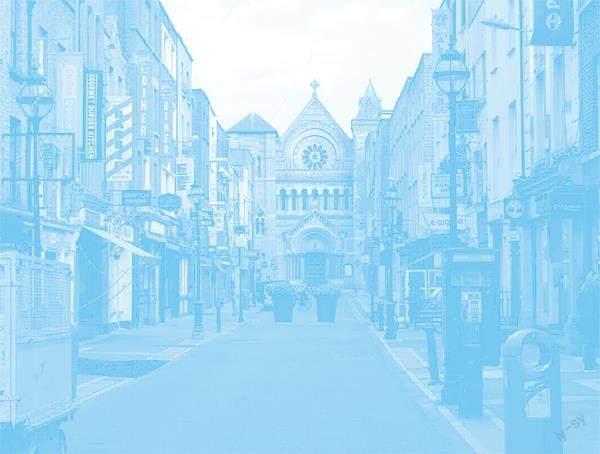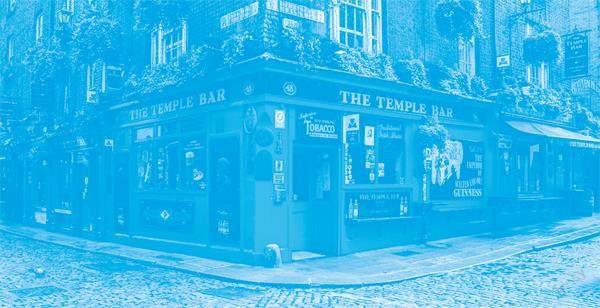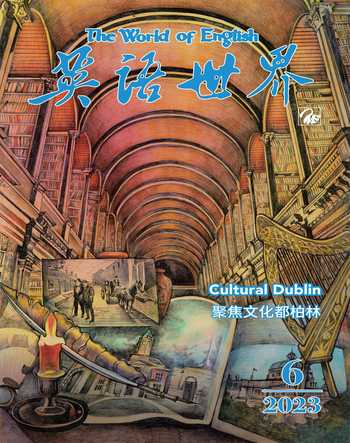City of Sociability社交之城
西沃恩·基尔费瑟 宁一中/译介


【导读】西沃恩·基尔费瑟的《都柏林文化史》(Dublin: A Cultural History)2005年由牛津大学出版,著名文论家伊格尔顿作序。全书凡九章,涉及到爱尔兰文化的各个方面。爱尔兰首都都柏林被誉为社交之城,而酒吧则是交际的重要场所。圣殿酒吧、迈克达德酒吧、宫殿酒吧都是都柏林的著名酒吧。到都柏林游览,少不了去参观这些酒吧并喝上一杯,感受那里酒吧的氛围是了解都柏林文化的一个重要方面。事实上,光顾都柏林酒吧的,有作家、诗人、歌手、演员、冒险家、政客、记者、律师、学生各色人等。这是一个地道的交际所在,到都柏林不去这些酒吧体验一下,离开的时候一定会带着遗憾。
Sometimes friends from overseas who are planning to visit Dublin ask me what they should see and do. I am happy enough to make suggestions until they ask the two questions I dread: Where should I go to hear live music, and which are the good pubs? Both these questions arise, I think, from the way that people choose to visit Dublin not to see anything in particular, but because they believe in its sociability. This, of course, is not a myth. Dublin is the most sociable of cities, although fifteen years ago one would have appended the caveat “unless youre gay”. Happily, things have changed.
時有朋自海外来,欲访都柏林,问我何处值得一看、何事值得一做,我都乐意为他们出谋划策。不过有两个问题让我害怕作答,那就是:上哪儿去听一场现场音乐会?哪里的酒吧最好?这些问题的提出,我想是因为这些人造访都柏林不是专门看什么,而是深信都柏林是一座社交之城。当然,这想法没错。都柏林确实是社交生活最为活跃的城市,尽管15年前大家往往会加上“同性恋当心”的提醒。可喜的是,情况已经发生了变化。
In the 1990s Dublin was marketed in Britain and Germany as a “stag night” and “office party” destination, with the new fast ferries (which cross from Holyhead in 100 minutes) and the cheap flights offered by Ryanair making it an easy place to spend a weekend. By the start of the twenty-first century the spread of low-budget airlines, adjustments in the exchange rates, European Union enlargement and changes in fashion saw a drop in that party tourism (which migrated to Prague and elsewhere).
20世纪90年代,都柏林在英国和德国是作为“告别单身之夜”和“办公室聚会”的所在而被推销的。因为新开辟了快船航道(从霍利黑德出发,100分钟就能到都柏林),瑞安航空公司也提供了便宜航班,去那里度周末就轻而易举了。21世纪刚开始,由于低价航班的扩张、汇率的调整、欧盟的扩大和时尚的变化,这个聚会旅游的打卡地风光不再(转去了布拉格和别的地方)。
Aspects of the heavy drinking culture were unattractive to other kinds of tourists, and Temple Bar, for instance, now actively discourages the “stag night” trade. That increase in tourism from the young caused some public order problems, but also contributed to a relaxed attitude that appeals strongly to multi-cultural tourists.
过度饮酒的文化对其他一些旅游者来说并无吸引力。比如,圣殿酒吧现在就积极支持取消“告别单身之夜”这一项目。来旅游的年轻人增多,尽管产生了一些公共秩序问题,却也增添了轻松气氛,大大吸引了多文化旅游者。
But sociability is not a commodity that can be ordered with a pint of stout. A visitor might get a lot of pleasure from visiting pubs that are beautifully dec-orated and pubs that have interesting historical associations. Many a visitor enjoys a drink in the Palace Bar or McDaids in the knowledge that these are places where Patrick Kavanagh1, Flann OBrien2 and Brendan Behan3 might have been seen in the 1940s and 1950s.
但社交并非商品,不可用一品脱烈性黑啤酒换得。装修漂亮的酒吧和能令人联想起很多有趣历史故事的酒吧,可能会让游客得到很多快乐。许多游客喜欢在皇宫酒吧或麦克戴兹喝上一杯,因为他们知道,20世纪40年代和50年代,帕特里克·卡瓦纳、弗兰·奥布赖恩和布伦丹·贝汉都可能光顾过此地。
Fans of Ulysses will probably go into Davy Byrnes because that is where Leopold Bloom had his lunch. Nearys was traditionally a theatrical bar, and Doheny & Nesbitts was always popular with politicians, journalists and lawyers. John Kehoes, the pub closest to the National Library, has a great traditional decor and is very busy in the evenings, with customers spilling out into the streets. The Republic of Ireland has recently introduced a ban on smoking in public places, and this is felt most dramatically in the changed atmosphere in pubs. J. P. Donleavys description of McDaids in the 1940s is a reminder that it is people, not places, who make great pubs:
《尤利西斯》的粉丝不妨去戴维·伯恩酒吧,因为那就是利奧波德·布鲁姆吃午饭的地方。尼亚里是一个传统的戏剧酒吧,而多尼-内斯比特酒吧则是政客、记者和律师们常去的地方。离国家图书馆最近的约翰·基欧酒吧有着很棒的传统装饰,晚上生意非常繁忙,大量顾客在那会儿涌上街头。最近,爱尔兰共和国实施了公共场合禁止抽烟的法令,使气氛大为不同,在酒吧最为显见。J. P.唐利维对20世纪40年代麦克戴兹酒吧的描写让我们明白,成就好酒吧的,不是场所,而是人:
If a drink were needed in the pub as it invariably was following anyones meeting one another for more than three minutes, folk would only have to descend the stairs, step out across the street and walk twenty yards to the corner, turn left by the exotic furs displayed in a window, and proceed past Tom Nisbets painting gallery and into John MacDaids pub. Which advertised “Where the drink is efficacious and the conversation effervescent”. Slowly but surely this converted church at 3 Harry Street with its cold, barren, lofty interior, its grim downstairs lavatory and a back door out to a side lane, became an established meeting place for poets, painters, writers, and various chancers and con men, the latter who, poor souls, erroneously thought such people worth associating with. Although this public house had a bemused owner and an extremely pleasant and understanding bartender, the only one in Dublin ever to have bought yours truly4 a drink, nevertheless this big grim room to have become celebrated in any manner, was a mystery to all who went there.
见面超过三分钟就需要到酒吧喝上一杯,这是常事——若如此,只需下楼梯,出门过马路,走20码至街角,在一个展示异国皮草的橱窗前左转,再往前经过汤姆·尼斯贝特画廊,就进入约翰·迈克达德酒吧了。酒吧的广告词是“畅饮热聊之地”。这个酒吧位于哈里街3号,由教堂改建而来,室内一片高冷萧瑟,连楼下的卫生间都阴森可怖,一扇后门连通外面的小巷,如今渐渐定型为诗人、画家、作家,以及各种投机者和骗子的固定聚集地。这帮投机者和骗子,一些可怜的家伙,错误地以为那些文艺界人士值得交往。这家酒吧有个风趣逗乐的老板,还有个讨人喜欢且善解人意的酒保(他是都柏林唯一请我喝了一杯的人)——尽管如此,这么一间森严的房舍如何变身成了鼎鼎大名的酒吧,这对所有去过的人来说依然是一个谜。
Likewise you will find the music you are interested in by talking to people and by looking at the papers, but if you have never had the slightest interest in Irish music do not expect to be able to walk into some charming little pub and have the locals entertain you.
同样,与人交谈或者看看报纸,都可以找到你喜欢的音乐。但倘若你对爱尔兰音乐没有丝毫兴趣,就不要指望能走进一个富有魅力的小酒吧,享受本地人带给你的快乐。
There are a fair number of buskers, particularly around Grafton Street and St. Stephens Green, and many pubs advertise live music and craic, ceilidh and ceol. Thirty years ago crack was a genuine slang term, applied to social occasions when conversation and drink flowed and people took real pleasure in one anothers company.
都柏林有很多街头艺人,格拉夫顿街和圣斯蒂芬绿地周围尤其多。很多酒吧打出广告,称有现场音乐演出,还可以 craic(神侃)、ceilidh(聚会)和 ceol(听曲)。30年前,crack是地道的俚语,用来描述人们结伴聊天喝酒、尽情享受的社交场合。
I have a feeling that it originated in the north and may have migrated to Dublin via students at Trinity College Dublin, which then had a large contingent of northerners. Some time in the 1990s, when Irish theme pubs swept across the world, it was gaelicized to craic. However sterling the crack, I do not think that any Irish person ever says that the craic is good, but there it is advertised all over the place. It is an odd promise to market.
我有一種感觉,该词源于北部,可能是经由都柏林圣三一学院的学生传到这里的,当时学院里有很多北方人。20世纪90年代的某个时候,爱尔兰主题酒吧风靡世界,这个词就被盖尔语化,变样成了craic。无论crack有多好,我都认为没有一个爱尔兰人会说craic很好,但这里随处可见用它做的广告。用这么个词来做推广,真是咄咄怪事。
A ceilidh is a social gathering which may—but need not—involve storytelling or music. When I was a child I always heard it used as a verb—“Shall we go down the lane and ceilidh with Bridget Ellen?” Ceol is the Irish for music.
ceilidh就是社交聚会,可以讲故事或听音乐,当然不一定都有。还在孩提时代,我就常常听到这个词用作动词,比如:“Shall we go down the lane and ceilidh with Bridget Ellen?”(我们要不要沿着这个巷子走,找布里奇特·艾伦聚聚去?) Ceol则是爱尔兰语里“音乐”的意思。
Big shows happen at The Point, which was built in 1878 as a train depot to service Dublins docks. The decline in shipping to the North Wall Quay saw the depot close in the mid-1950s. In 1987 it was purchased by a local businessman, who transformed the disused building into a major music venue. It opened in 1988 and has presented many major acts, including David Bowie5, James Brown6, Bob Dylan7 etc.
大型演出一般在波因特剧院举办。波因特剧院建于1878年,当时是为都柏林各个码头服务的火车站。由于北墙码头水运的式微,这个站点在20世纪50年代中期关闭了。1987年,当地的一位商人把它买了下来,将这个废弃的建筑改造成了一个重要的音乐演出场所。自1988年开业以来,这里已经举办了很多大牌歌手的演唱会,包括大卫·鲍伊、詹姆斯·布朗、鲍勃·迪伦等。
In 1967 Seán Corcoran8 and Mary McGannon started the Tradition Club at Slatterys, which was for over twenty years one of the best venues for traditional music in the city. Young people in Dublin are wild about music, and you might experience your most enjoyable gig if you simply listen for music from the street, and go into a bar or café to watch a teenage band play in public for the first time.
1967年,肖恩·科科伦和玛丽·麦克甘农在斯莱特里酒吧创办了“传统俱乐部”——20多年来,这里一直是这座城市最好的传统音乐演出场所之一。都柏林的年轻人对音乐非常狂热,即使你只是想在街头听听音乐,那么走进一家酒吧或咖啡馆,观看一支青少年乐队的首次现场演出,都很可能会有一场最享受的观演体验。
Your first day in Dublin is always your worst. So, with nice ambiguity, claimed John Berryman9, the American poet who was sometimes drunk in Dublin. Give into it a bit, and Dublin gets better.
你在都柏林的第一天总是最糟糕的。——约翰·贝里曼如是说,这位美国诗人动辄在都柏林喝醉,话中模棱两可的意味颇堪咀嚼。浸染多一分,都柏林会更赏心悦目。

